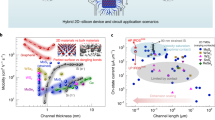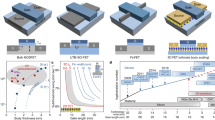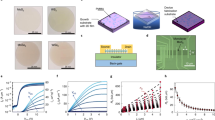Abstract
Two-dimensional (2D) materials could potentially be used to develop advanced monolithic integrated circuits. However, despite impressive demonstrations of single devices and simple circuits—in some cases with performance superior to those of silicon-based circuits—reports on the fabrication of integrated circuits using 2D materials are limited and the creation of large-scale circuits remains in its infancy. Here we examine the development of integrated circuits based on 2D layered materials. We assess the most advanced circuits fabricated so far and explore the key challenges that need to be addressed to deliver highly scaled circuits. We also propose a roadmap for the future development of integrated circuits based on 2D layered materials.
This is a preview of subscription content, access via your institution
Access options
Access Nature and 54 other Nature Portfolio journals
Get Nature+, our best-value online-access subscription
$29.99 / 30 days
cancel any time
Subscribe to this journal
Receive 12 digital issues and online access to articles
$119.00 per year
only $9.92 per issue
Buy this article
- Purchase on Springer Link
- Instant access to full article PDF
Prices may be subject to local taxes which are calculated during checkout



Similar content being viewed by others
References
The International Roadmap for Devices and Systems 2020 Edition (IRDS, IEEE, accessed 24 December 2020); https://irds.ieee.org/editions/2020
Kilby, J. S. Miniaturized electronic circuits. US patent 3,138,743 (1964).
Noyce, R. N. Semiconductor device-and-lead structure. US patent 2,981,877 (1961).
Kahng, D. Electric field controlled semiconductor device. US patent 3,102,230 (1963).
Teal, G. K. Single crystals of germanium and silicon—basic to the transistor and integrated circuit. IEEE Trans. Electron. Dev. 23, 621–639 (1976).
Liu, R., Pai, C. & Martinez, E. Interconnect technology trend for microelectronics. Solid-State Electron. 43, 1003–1009 (1999).
Gusev, E. P. et al. Ultrathin high-k gate stacks for advanced CMOS devices. In International Electron Devices Meeting Technical Digest 20.1.1–20.1.4 (IEEE, 2001).
Kim, K. T. et al. Tungsten silicide/titanium nitride compound gate for submicron CMOSFET. In 1990 Symposium on VLSI Technology Digest of Technical Papers 115–116 (IEEE, 1990).
Balaram, V. Rare earth elements: a review of applications, occurrence, exploration, analysis, recycling and environmental impact. Geosci. Front. 10, 1285–1303 (2019).
Novoselov, K. S. et al. Electric field effect in atomically thin carbon films. Science 306, 666–669 (2004).
Wang, N. C. et al. Replacing copper interconnects with graphene at a 7-nm node. In Proc. IEEE International Interconnect Technology Conference (IITC) 1–3 (IEEE, 2017).
Butler, S. Z. et al. Progress, challenges and opportunities in two-dimensional materials beyond graphene. ACS Nano 7, 2898–2926 (2013).
Ji, Y. et al. Boron nitride as two dimensional dielectric: reliability and dielectric breakdown. Appl. Phys. Lett. 108, 012906 (2016).
Grande, M. et al. Optically transparent wideband CVD graphene-based microwave antennas. Appl. Phys. Lett. 112, 251103 (2018).
Lembke, D. & Kis, A. Breakdown of high-performance monolayer MoS2 transistors. ACS Nano 6, 10070–10075 (2012).
Li, N. et al. Large-scale flexible and transparent electronics based on monolayer molybdenum disulfide field-effect transistors. Nat. Electron. 3, 711–717 (2020).
Britnell, L. et al. Electron tunneling through ultrathin boron nitride crystalline barriers. Nano Lett. 12, 1707–1710 (2012).
Akinwande, D. et al. Two-dimensional flexible nanoelectronics. Nat. Commun. 5, 5678 (2014).
Backes, C. et al. Production and processing of graphene and related materials. 2D Mater. 7, 022001 (2020).
Han, S., Garcia, A. V., Oida, S., Jenkins, K. A. & Haensch Graphene radio frequency receiver integrated circuit. Nat. Commun. 5, 3086 (2014).
Lee, J. et al. Wafer-scale growth of single-crystal monolayer graphene on reusable hydrogen-terminated germanium. Science 344, 286–289 (2014).
Chen, T. et al. Wafer-scale single-crystal hexagonal boron nitride monolayers on Cu (111). Nature 579, 219–223 (2020).
Lin, D. et al. Dual gate synthetic WS2 MOSFETs with 120 µS/µm Gm 2.7 µF/cm2 capacitance and ambipolar channel. In Proc. 2020 IEEE International Electron Devices Meeting (IEDM) 3.6.1–3.6.4 (IEEE, 2020).
Zhang, Y. et al. Thickness considerations of two-dimensional layered semiconductors for transistor applications. Sci. Rep. 6, 29615 (2016).
Smithe, K., Suryavanshi, S. V., Rojo, M. M., Tedjarati, A. D. & Pop, E. Low variability in synthetic monolayer MoS2 devices. ACS Nano 11, 8456–8463 (2020).
Huang, X. et al. Binder-free highly conductive graphene laminate for low cost printed radio frequency applications. Appl. Phys. Lett. 106, 203105 (2015).
Pan, K. et al. Sustainable production of highly conductive multilayer graphene ink for wireless connectivity and IoT applications. Nat. Commun. 9, 5197 (2018).
Sarycheva, A. et al. 2D titanium carbide (MXene) for wireless communication. Sci. Adv. 4, 0920 (2018).
Han, M. et al. Solution-processed Ti3C2Tx MXene antennas for radio frequency communication. Adv. Funct. Mater. 33, 2003225 (2021).
Zhang, X. et al. Two-dimensional MoS2-enabled flexible rectenna for Wi-Fi-band wireless energy harvesting. Nature 566, 368–372 (2019).
Kim, M. et al. Zero-static power radio-frequency switches based on MoS2 atomristors. Nat. Commun. 9, 2524 (2018).
Kim, M. et al. Analogue switches made from boron nitride monolayers for application in 5G and terahertz communication systems. Nat. Electron. 3, 479–485 (2020).
Chen, S. et al. Wafer-scale integration of two-dimensional materials in high-density memristive crossbar arrays for artificial neural networks. Nat. Electron. 3, 638–645 (2020).
Lin, Y. et al. Wafer-scale graphene integrated circuit. Science 332, 1294–1297 (2011).
Li, T. et al. MXene-graphene field-effect transistor sensing of influenza virus and SARS-CoV-2. ACS Omega 6, 6643–6653 (2021).
Marin, J. F. G. et al. MoS2 photodetectors integrated with photonic circuits. npj 2D Mater. Appl. 3, 14 (2019).
Peyskens, F. et al. Integration of single photon emitters in 2D layered materials with a silicon nitride photonic chip. Nat. Commun. 10, 4435 (2019).
Goossens, S. et al. Broadband image sensor array based on graphene–CMOS integration. Nat. Photon. 11, 366–371 (2017).
Mennel, L. et al. Ultrafast machine vision with 2D material neural network image sensors. Nature 579, 62–66 (2020).
Xue, F. et al. Optoelectronic ferroelectric domain-wall memories made from a single van der Waals ferroelectric. Adv. Funct. Mater. 30, 2004206 (2020).
Kamarauskas, M. et al. Photovoltaic effect-driven IR response of heterojunctions obtained by direct CVD synthesis of MoS2 nanolayers on crystalline silicon. Nanotechnology 31, 425603 (2020).
Leng, T. et al. Printed graphene/WS2 battery-free wireless photosensor on papers. 2D Mater. 7, 024004 (2020).
Velusamy, D. et al. MXenes for plasmonic photodetection. Adv. Mater. 31, 1807658 (2019).
Patel, D. Apple’s A14 packs 134 million transistors/mm2, but falls short of TSMC’s density claims. SemiAnalysis (27 October 2020).
Adam, G. C. et al. 3-D memristor crossbars for analog and neuromorphic computing applications. IEEE Trans. Electron Devices 64, 312–318 (2017).
Lanza, M., Smets, Q., Huyghebaert, C. & Li, L. Yield, variability, reliability and stability of two-dimensional materials based solid-state electronic devices. Nat. Commun. 11, 5689 (2020).
Zhang, Q. et al. Simultaneous synthesis and integration of two-dimensional electronic components. Nat. Electron. 2, 164–170 (2019).
Marega, G. M. et al. Logic-in-memory based on an atomically thin semiconductor. Nature 587, 72–77 (2020).
Dodda, A. et al. Graphene-based physically unclonable functions that are reconfigurable and resilient to machine learning attacks. Nat. Electron. 4, 364–374 (2021).
Polyushkin, D. K. et al. Analogue two-dimensional semiconductor electronics. Nat. Electron. 3, 486–491 (2020).
Wachter, S., Polyushkin, D. K., Bethge, O. & Mueller, T. A microprocessor based on a two-dimensional semiconductor. Nat. Commun. 8, 14948 (2017).
Lin, S. et al. Solution-processable 2D semiconductors for high performance large-area electronics. Nature 562, 254–258 (2018).
Conti, S. et al. Low-voltage 2D materials-based printed field-effect transistors for integrated digital and analog electronics on paper. Nat. Commun. 11, 3566 (2020).
Wang, Z., Kim, H. & Alshareef, H. N. Oxide thin-film electronics using All-MXene electrical contacts. Adv. Mater. 30, 1706656 (2018).
Smets Q. et al. Ultra-scaled MOCVD MoS2 MOSFETs with 42-nm contact pitch and 250-µA/µm drain current. In Proc. 2019 IEEE International Electron Devices Meeting (IEDM) 23.2.1–23.2.4 (IEEE, 2019).
Cheng, C.-C. et al. First demonstration of 40-nm channel length top-gate WS2 pFET using channel area-selective CVD growth directly on SiOx/Si substrate. In Proc. 2019 Symposium on VLSI Technology T244–T245 (IEEE, 2019).
Shulaker, M. M. et al. Carbon nanotube computer. Nature 501, 526–530 (2013).
Hills, G. et al. Modern microprocessor built from complementary carbon nanotube transistors. Nature 572, 595–602 (2017).
Lyu, B. et al. Large-area MXene electrode array for flexible electronics. ACS Nano 13, 11392–11400 (2019).
Wang, Y. et al. High on/off ratio black phosphorus based memristor with ultra-thin phosphorus oxide layer. Appl. Phys. Lett. 115, 193503 (2019).
Sun, L. et al. Self-selective van der Waals heterostructures for large scale memory array. Nat. Commun. 10, 3161 (2019).
Shi, Y. et al. Electronic synapses made of layered two-dimensional materials. Nat. Electron. 1, 458–465 (2018).
Shen, Y. et al. Variability and yield in h-BN-based memristive circuits: the role of each type of defect. Adv. Mater. 33, 2103656 (2021).
Sivan, M. et al. All WSe2 1T1R resistive RAM cell for future monolithic 3D embedded memory integration. Nat. Commun. 10, 5201 (2019).
Wang, C. H. et al. 3D monolithic stacked 1T1R cells using monolayer MoS2 FET and h-BN RRAM fabricated at low (150 °C) temperature. In Proc. IEEE International Electron Devices Meeting (IEDM) 22–25 (IEEE, 2018).
Lee, H.-S. et al. Dual-gated MoS2 memtransistor crossbar array. Adv. Funct. Mater. 30, 2003683 (2020).
Feng, X. et al. Self-selective multi-terminal memtransistor crossbar array for in-memory computing. ACS Nano 15, 1764–1774 (2020).
Son, D. et al. Colloidal synthesis of uniform-sized molybdenum disulfide nanosheets for wafer-scale flexible nonvolatile memory. Adv. Mater. 28, 9326–9332 (2016).
Ielmini, D. & Wong, H.-S. P. In-memory computing with resistive switching devices. Nat. Electron. 1, 333–343 (2018).
Wen, C. et al. Advanced data encryption using 2D materials. Adv. Mater. 33, 2100185 (2021).
Baijieteng Technology Corporation (BTC, accessed 13 January 2020); http://bjtiot.com/english/
Autovision Program of Spearhead Projects (Graphen Flagship, accessed 13 January 2020); https://graphene-flagship.eu/innovation/spearheads/c3-sh08-autovision/
Huawei achieves major breakthrough in graphene-assisted high temperature Li-ion batteries. Huawei (1 December 2016); https://www.huawei.com/en/news/2016/12/Graphene-Assisted-Li-ion-Batteries
Shi, Y. et al. Engineering wafer-scale epitaxial two-dimensional materials through sapphire template screening for advanced high- performance nanoelectronics. ACS Nano 15, 9482–9494 (2021).
Wang, L. et al. Epitaxial growth of a 100-square-centimetre single-crystal hexagonal boron nitride monolayer on copper. Nature 570, 91–95 (2019).
Wu, T. et al. Fast growth of inch-sized single-crystalline graphene from a controlled single nucleus on Cu–Ni alloys. Nat. Mater. 15, 43–47 (2016).
Lee, J. S. et al. Wafer-scale single-crystal hexagonal boron nitride film via self-collimated grain formation. Science 362, 817–821 (2018).
Phommahaxay, A. et al. The growing application field of laser debonding: from advanced packaging to future nanoelectronics. In Proc. 2019 International Wafer Level Packaging Conference (IWLPC) 1–8 (IEEE, 2019).
Kim, M. et al. Sheet resistance analysis of interface-engineered multilayer graphene: mobility versus sheet carrier concentration. ACS Appl. Mater. Interfaces 12, 30932–30940 (2020).
Knobloch, T. et al. The performance limits of hexagonal boron nitride as an insulator for scaled CMOS devices based on two-dimensional materials. Nat. Electron. 4, 98–108 (2021).
Mun, J. et al. Low-temperature growth of layered molybdenum disulphide with controlled clusters. Sci. Rep. 6, 21854 (2016).
Hartnett, J. G., Fowler, A. C., Tobar, M. E. & Krupka, J. The microwave characterization of single crystal lithium and calcium fluoride at cryogenic temperatures. IEEE T. Ultrason. Ferr. 51, 380–386 (2004).
Kim, K. K. et al. Synthesis and characterization of hexagonal boron nitride film as a dielectric layer for graphene devices. ACS Nano 6, 8583–8590 (2012).
Koma, A., Saiki, K. & Sato, Y. Heteroepitaxy of a two-dimensional material on a three-dimensional material. Appl. Surf. Sci. 41, 451–456 (1990).
Wen, C. et al. Dielectric properties of ultrathin CaF2 ionic crystals. Adv. Mater. 32, 2002525 (2020).
Illarionov, Y. Y. et al. Ultrathin calcium fluoride insulators for two-dimensional field-effect transistors. Nat. Electron. 2, 230–235 (2019).
Wang, L. et al. One-dimensional electrical contact to a two-dimensional materials. Science 342, 614–617 (2013).
Torrisi, F. et al. Inkjet-printed graphene electronics. ACS Nano 6, 2992–3006 (2012).
Vescio, G. Inkjet-Printed Flexible Electronic Devices: from High-k Capacitors to h-BN/Graphene Thin Film Transistors. PhD thesis, Univ. Barcelona (2017).
Hsieh, Y., Su, W., Huang, C. & Su, C. Solution-processed black phosphorus nanoflakes for integrating nonvolatile resistive random access memory and the mechanism unveiled. Nanotechnology 30, 445702 (2019).
2D Semiconductors (2DS, accessed 13 January 2020); https://www.2dsemiconductors.com/
Afanas’ev, V. V. Band alignment at interfaces of two-dimensional materials: internal photoemission analysis. J. Phys. Condens. Matter 32, 413002 (2020).
Xu, K. et al. Sub-10-nm nanopattern architecture for 2D material field-effect transistors. Nano Lett. 17, 1065–1070 (2017).
Pan, C. et al. Coexistence of grain-boundaries-assisted bipolar and threshold resistive switching in multilayer hexagonal boron nitride. Adv. Funct. Mater. 27, 1604811 (2017).
Chen, Y., Gong, X. & Gai, J. Progress and challenges in transfer of large-area graphene films. Adv. Sci 3, 1500343 (2016).
Smets, Q. et al. Source of variability in scaled MoS2 FETs. In Proc. 2020 IEEE International Electron Devices Meeting (IEDM) 3.1.1–3.1.4 (IEEE, 2020).
Lupina, G. et al. Residual metallic contamination of transferred chemical vapor deposited graphene. ACS Nano 9, 4776–4785 (2015).
Lim, J. Y. et al. Homogeneous 2D MoTe2 p–n junctions and CMOS inverters formed by atomic-layer deposition-induced doping. Adv. Mater. 29, 1701798 (2017).
Yu, L. et al. High-performance WSe2 complementary metal oxide semiconductor technology and integrated circuits. Nano Lett. 15, 4928–4934 (2015).
Suh, Y., Shin, D. & Chun, Y. T. Micro-to-nanometer patterning of solution-based materials for electronics and optoelectronics. RSC Adv. 9, 38084–38104 (2019).
Hyun, W. J. et al. Printable hexagonal boron nitride ionogles. Faraday Discuss. 227, 92–104 (2021).
Si, K. et al. Improving photoelectric performance of MoS2 photoelectrodes by annealing. Ceram. Int. 44, 21153–21158 (2018).
Huang, S. et al. Thermal bubble inkjet printing of water-based graphene oxide and graphene inks on heated substrate. J. Phys. D 51, 135302 (2018).
Franklin, A. D. Nanomaterials in transistors: from high-performance to thin-film applications. Science 349, aab2750 (2015).
Liu, L. et al. Transferred van der Waals metal electrodes for sub-1-nm MoS2 vertical transistors. Nat. Electron. 4, 342–347 (2021).
Shin, Y. S. et al. Mobility engineering in vertical field effect transistors based on van der Waals heterostructures. Adv. Mater. 30, 1704435 (2018).
Yu, W. J. et al. Vertically stacked multi-heterostructures of layered materials for logic transistors and complementary inverters. Nat. Mater. 12, 246–252 (2013).
Qiu, C. et al. Dirac-source field-effect transistors as energy-efficient, high-performance electronic switches. Science 361, 387–392 (2018).
Tang, Z. et al. A steep-slope MoS2/graphene Dirac-source field-effect transistor with a large drive current. Nano Lett. 21, 1758–1764 (2021).
MUSE Semiconductor (MUSE, accessed 5 October 2021); https://www.musesemi.com/shared-block-tapeout-pricing
McDonnell, S. et al. HfO2 on MoS2 by atomic layer deposition: adsorption mechanisms and thickness scalability. ACS Nano 7, 10354–10361 (2013).
Liu, Y. et al. Approaching the Schottky–Mott limit in van der Waals metal–semiconductor junctions. Nature 557, 696–700 (2018).
Li, W. et al. Uniform and ultrathin high-κ gate dielectrics for two-dimensional electronic devices. Nat. Electron. 2, 563–571 (2019).
Li, T. et al. A native oxide high-k gate dielectric for two-dimensional electronics. Nat. Electron. 3, 473–478 (2020).
Park, H., Shin, G. H., Lee, K. J. & Choi, S.-Y. Atomic-scale etching of hexagonal boron nitride for device integration based on two-dimensional materials. Nanoscale 10, 15205–15212 (2018).
Lim, W. S. et al. Atomic layer etching of graphene for full graphene device fabrication. Carbon 50, 429–435 (2012).
Xu, X. et al. Enhanced quality of wafer-scale MoS2 films by a capping layer annealing process. Adv. Funct. Mater. 53, 1908040 (2020).
Jung, Y. et al. Transferred via contacts as a platform for ideal two-dimensional transistors. Nat. Electron. 2, 187–194 (2019).
Hui, F. & Lanza, M. Scanning probe microscopy for advanced nanoelectronics. Nat. Electron. 2, 221–229 (2019).
Xiao, Y. et al. Highly accurate thickness determination of 2D materials. Cryst. Res. Technol. 56, 2100056 (2021).
Lanza, M. et al. Standards for the characterization of endurance in resistive switching devices. ACS Nano https://doi.org/10.1021/acsnano.1c06980 (2021).
Song, H. et al. Two-dimensional materials for thermal management applications. Joule 2, 442–463 (2018).
Deshmukh, S., Rojo, M. M., Yalon, E., Vaziri, S. & Pop, E. Probing self-heating in RRAM devices by sub-100-nm spatially resolved thermometry. In Proc. 2018 76th Device Research Conference (DRC) 1–2 (IEEE, 2018).
Kaushik, N. et al. Reversible hysteresis inversion in MoS2 field effect transistors. njp 2D Mater. Appl. 1, 34 (2017).
Wang, B. et al. Experimental observation and mitigation of dielectric screening in hexagonal boron nitride based resistive switching devices. Cryst. Res. Technol. 53, 1800006 (2018).
Molle, A. et al. Silicene, silicene derivatives and their device applications. Chem. Soc. Rev. 47, 6370–6387 (2018).
Abate, Y. et al. Recent progress on stability and passivation of black phosphorus. Adv. Mater. 30, 1704749 (2018).
Acknowledgements
This work has been supported by King Abdullah University of Science and Technology (KAUST). M.L. acknowledges S. Pazos from the King Abdullah University of Science and Technology for technical advice on 2D-LMs/CMOS hybrid integration.
Author information
Authors and Affiliations
Contributions
M.L. conceived the idea. K.Z. performed the literature research. K.Z. and M.L. wrote the manuscript. C.W., A.A.A., F.X., X.X., V.T., X.Z. and H.N.A. revised the manuscript, included some portions of text and provided additional references. All authors read the final manuscript.
Corresponding author
Ethics declarations
Competing interests
The authors declare no competing interests.
Additional information
Peer review information Nature Electronics thanks Cinza Casiraghi and Xiangfeng Duan for their contribution to the peer review of this work.
Publisher’s note Springer Nature remains neutral with regard to jurisdictional claims in published maps and institutional affiliations.
Rights and permissions
About this article
Cite this article
Zhu, K., Wen, C., Aljarb, A.A. et al. The development of integrated circuits based on two-dimensional materials. Nat Electron 4, 775–785 (2021). https://doi.org/10.1038/s41928-021-00672-z
Received:
Accepted:
Published:
Issue Date:
DOI: https://doi.org/10.1038/s41928-021-00672-z
This article is cited by
-
Homojunction-loaded inverters based on self-biased molybdenum disulfide transistors for sub-picowatt computing
Nature Electronics (2024)
-
Three-dimensional integration of two-dimensional field-effect transistors
Nature (2024)
-
Stochastic resonance in 2D materials based memristors
npj 2D Materials and Applications (2024)
-
Monolithic 3D integration of 2D transistors and vertical RRAMs in 1T–4R structure for high-density memory
Nature Communications (2023)
-
Nonlinear restructuring of patterned thin films by residual stress engineering into out-of-plane wavy-shaped electrostatic microactuators for high-performance radio-frequency switches
Microsystems & Nanoengineering (2023)



